Monitoring the Thermal Degradation of Two Spruce Species, (Picea abies L., Picea rubens Sarg.), Cherry (Prunus avium), and Oak (Quercus spp.) Under the Influence of Radiant Heat
Abstract
1. Introduction
2. Methodology
3. Results and Discussion
4. Results of Spruce Thermal Degradation by Thermal Loading
5. Results of Red Spruce Thermal Degradation by Thermal Loading
6. Results of Cherry Thermal Degradation by Thermal Loading
7. Results of Oak Thermal Degradation by Thermal Loading
8. Conclusions
Author Contributions
Funding
Institutional Review Board Statement
Informed Consent Statement
Data Availability Statement
Conflicts of Interest
References
- Zelinka, S.L.; Altgen, M.; Emmerich, L.; Guigo, N.; Keplinger, T.; Kymäläinen, M.; Thybring, E.E.; Thygesen, L.G. Review of wood modification and wood functionalization technologies. Forests 2022, 13, 1004. [Google Scholar] [CrossRef]
- Properties of Wood. Vlastnosti Dřeva a Dřevostaveb. Stavba Dřeva—Část 1/2. [Properties of Wood and Wooden Buildings. Wood Construction—Part 1/2]. Available online: https://www.mezistromy.cz/vlastnosti-dreva-a-drevostaveb/stavba-dreva-cast-1-2/odborny (accessed on 12 February 2024). (In Sczech).
- Sergeev, M.; Rimshin, V.; Lukin, M.; Zdralovic, N. Multi-span composite beam. IOP Conf. Ser. Mater. Sci. Eng. 2020, 896, 012058. [Google Scholar] [CrossRef]
- Kristak, L.; Kubovský, I.; Réh, R. New challenges in wood and wood-based materials. Polymers 2021, 13, 2538. [Google Scholar] [CrossRef] [PubMed]
- Zhu, J.L.; Shi, Y.; Fang, L.Q.; Liu, X.E.; Ji, C.J. Patterns and determinants of wood physical and mechanical properties across major tree species in China. Sci. China-Life Sci. 2015, 58, 602–612. [Google Scholar] [CrossRef]
- Wimmer, R.; Johansson, M. Effects of reaction wood on the performance of wood and wood-based products. In The Biology of Reaction Wood; Gardiner, B., Barnett, J., Saranpaa, P., Gril, J., Eds.; Springer Series in Wood Science; Springer: Berlin/Heidelberg, Germany, 2014. [Google Scholar] [CrossRef]
- Cabrera, F.C.; Job, A.E. Natural rubber/wood composite foam: Thermal insulation and acoustic isolation materials for construction. Cell. Polym. 2023, 42, 55–72. [Google Scholar] [CrossRef]
- Ranefjärd, O.; Strandberg-de Bruijn, P.; Wadsö, L. Hygrothermal properties and performance of bio-based insulation materials locally sourced in Sweden. Materials 2024, 17, 2021. [Google Scholar] [CrossRef]
- Salonvaara, M.; Desjarlais, A. Impact of insulation strategies of cross-laminated timber assemblies on energy use, peak demand, and carbon emissions. Buildings 2024, 14, 1089. [Google Scholar] [CrossRef]
- Asyraf, M.R.M.; Ishak, M.R.S.; Sapuan, M.; Yidris, N.; Ilyas, R.A. Woods and composites cantilever beam: A comprehensive review of experimental and numerical creep methodologies. J. Mater. Res. Technol. 2020, 9, 6759–6776. [Google Scholar] [CrossRef]
- Hrebenárová, E.; Wald, F. Comparison of mechanical properties of the eldest larch wood construction with oak wood and spruce wood. Wood Res. 2022, 67, 612–624. [Google Scholar] [CrossRef]
- Bianco, I.; Thiébat, F.; Carbonaro, C.; Pagliolico, S.; Blengini, G.A.; Comino, E. Life Cycle Assessment (LCA)-based tools for the eco-design of wooden furniture. J. Clean. Prod. 2021, 324, 129249. [Google Scholar] [CrossRef]
- Abu, F.; Saman, M.Z.M.; Garza-Reyes, J.A.; Gholami, H.; Zakuan, N. Challenges in the implementation of lean manufacturing in the wood and furniture industry. J. Manuf. Technol. Manag. 2022, 33, 103–123. [Google Scholar] [CrossRef]
- Suandi, M.E.M.; Amlus, M.H.; Hemdi, A.R.; Abd Rahim, S.Z.; Ghazali, M.F.; Rahim, N.L. A review on sustainability characteristics development for wooden furniture design. Sustainability 2022, 14, 8748. [Google Scholar] [CrossRef]
- Grexa, O.; Horvathova, E.; Osvald, A. Cone calorimeter studies of wood species. Proc. Korea Inst. Fire Sci. Eng. Conf. 1997, 11a, 77–84. [Google Scholar]
- Košík, M.; Luzáková, V.; Reiser, V.; Blažej, A. Thermal degradation and flammability of cellulosics. Fire Mater. 1976, 1, 19–23. [Google Scholar] [CrossRef]
- Košík, M.; Reiser, V.; Blažej, A. Thermoanalytical studies of combustion of cellulosics and activity of fire retardants. J. Therm. Anal. Calorim. 1982, 23, 51–64. [Google Scholar] [CrossRef]
- Terrill, T.B.; Montgomery, R.R.; Reinhardta, C.F. Toxic gases from fires. Science 1978, 200, 1343–1347. [Google Scholar] [CrossRef]
- Babrauskas, V.; Krasny, J. Fire Behavior of Upholstered Furniture (NBS Monograph 173). In NIST Interagency/Internal Report (NISTIR); National Institute of Standards and Technology: Gaithersburg, MD, USA, 1985. [Google Scholar]
- Babrauskas, V.; Lawson, J.; Walton, W.; Twilley, W. Upholstered Furniture Heat Release Rates Measured with a Furniture Calorimeter. In NIST Interagency/Internal Report (NISTIR); National Institute of Standards and Technology: Gaithersburg, MD, USA, 1982. [Google Scholar]
- Réh, R.; Osvald, A. Contribution to the fire retardant treatment of flax board panels. Folia For. Pol. Ser. B 1996, 27, 79–83. Available online: https://ffp.matlibhax.com/pdf/27/Folia%20Forestalia%20Pol%2027-9%20Reh%20Osvald.pdf (accessed on 10 May 1996).
- Balog, K.; Košík, Š.; Košík, M.; Reiser, V.; Šimek, I. Application df thermal analysis procedures to the study pyrolytic and flammability of some polymers. Thermochim. Acta 1985, 93, 167–170. [Google Scholar] [CrossRef]
- Bučko, J.; Osvald, A. Rozklad Dreva Teplom A Ohňom [Wood Degradation by Heat and Fire]; Technical University in Zvolen: Zvolen, Slovakia, 1998. (In Slovak) [Google Scholar]
- Takashi, H.; Yoshinori, H.; Hidetoshi, T.; Shuji, Y. Thermal degradation of wood and its constituents on smoldering combustion in oxygen atmosphere. Fire Sci. Technol. 1985, 5, 55–68. [Google Scholar] [CrossRef]
- Šimkovic, I.; Balog, K.; Csomorová, K. Thermal degradation and thermooxidation of O-Acetyl-(4-O-methyl-D-glucurono)-D-xylan and related derivatives. Holzforschung 1995, 49, 512–516. [Google Scholar] [CrossRef]
- Madyaratri, E.W.; Ridho, M.R.; Iswanto, A.H.; Osvaldová, L.M.; Lee, S.H.; Antov, P. Effect of lignin or lignosulfonate addition on the fire resistance of areca (Areca catechu) particleboards bonded with ultra-low-emitting urea-formaldehyde resin. Fire 2023, 6, 299. [Google Scholar] [CrossRef]
- Vavrčík, H. Anatomická Stavba Dřeva [Anatomical Structure of Wood]; Mendel University in Brno: Brno, Czech Republic, 2017. (In Czech) [Google Scholar]
- Gašparík, M.; Rezaei, F.; Karami, E.; Das, S.; Kytka, T.; Vlk, L.; Corleto, R.; Ditommaso, G. Vplyv striedania mrazu a vysokých teplôt na pevnosť v ťahu lepeného smreka nórskeho (Picea abies (L.) H. Karst.) a smrekovec európsky (Larix decidua Mill.). [Effect of alternation of frost and high temperatures on the tensile strength of glued Norway spruce (Picea abies (L.) H. Karst.) and European larch (Larix decidua Mill.)]. Európsky Vestník Dreva A Drevených Výrobkov. [Eur. J. Wood Wood Prod.] 2020, 80, 1343–1350. [Google Scholar]
- Gašparík, M.; Karami, E.; Rezaei, F.; Kytka, T.; Das, S.; Lesáková, D. Vplyv striedania nižších a vyšších teplôt na ohybové vlastnosti lepeného smreka nórskeho (Picea abies (L.) H. Karst.) a smrekovca európskeho (Larix decidua Mill.) [The effect of alternation of lower and higher temperatures on the bending properties of glued Norway spruce (Picea abies (L.) H. Karst.) and European larch (Larix decidua Mill.)]. Lesy [Forests] 2022, 13, 364. [Google Scholar]
- Zachar, M.; Čabalová, I.; Kačíková, D.; Zacharová, L. Vplyv tepelného toku na požiarnotechnické a chemické vlastnosti smrekového dreva (Picea abies L.) [Effect of heat flow on the fire-technical and chemical properties of spruce wood (Picea abies L.)]. Materiály [Materials] 2021, 14, 4989. [Google Scholar]
- Čabalová, I.; Zachar, M.; Kačík, F.; Tribulová, T. Impact of thermal loading on selected chemical and morphological properties of spruce ThermoWood. BioResources 2019, 14, 387–400. [Google Scholar] [CrossRef]
- Cziegler, A.; Kaschnitz, E. Thermophysical properties of beech wood in the range from room Ttmperature to 900 °C. Int. J. Thermophys. 2024, 45, 26. [Google Scholar] [CrossRef]
- Maeda, K.; Tsunetsugu, Y.; Miyamoto, K.; Shibusawa, T. Thermal properties of wood measured by the hot-disk method: Comparison with thermal properties measured by the steady-state method. J. Wood Sci. 2021, 67, 20. [Google Scholar] [CrossRef]
- Harangozó, J.; Tureková, I.; Marková, I.; Hašková, A.; Králik, R. Study of the influence of heat flow on the time to ignition of spruce and beech wood. Appl. Sci. 2024, 14, 4237. [Google Scholar] [CrossRef]
- Fire Statistics in Slovakia. Štatistika Požiarovosti na Slovensku. Available online: https://www.minv.sk/?statistika-poziarovosti-na-slovensku-2 (accessed on 9 December 2024). (In Slovak).
- Oreňák, M.; Vido, J.; Hríbik, M.; Bartik, M. Interception process of spruce in the phase of disintegration in the Western Tatras. Rep. For. Res. 2013, 58, 360–369. [Google Scholar]
- Caboun, V. Draft of strategy, adaptation and mitigation measures from the viewpoint of climate change impact on Norway spruce tree in Slovakia. Cent. Eur. For. J. 2009, 55, 215–238. [Google Scholar]
- Jaloviar, P.; Kýpeťová, M.; Kucbel, S.; Vencurik, J.; Pittner, J. Density and height structure of natural regeneration in mountain spruce forest of the Polana (Slovakia). Rep. For. Res. 2017, 62, 7–15. [Google Scholar]
- Tudor, E.M.; Dettendorfer, A.; Kain, G.; Barbu, M.C.; Réh, R.; Krišťák, Ľ. Sound-absorption coefficient of bark-based insulation panels. Polymers 2020, 12, 1012. [Google Scholar] [CrossRef] [PubMed]
- Jaďuďová, J.; Hroncová Vicianová, J. IMS Tools in selected Slovak paper-pulp and pulp enterprises in the context of CSR. Acta Univ. Matthiae Belii Ser. Environ. Manage. 2017, 19, 55–62. [Google Scholar] [CrossRef]
- Koo, K.A.; Madden, M.; Patten, B.C. Projection of red spruce (Picea rubens Sargent) habitat suitability and distribution in the Southern Appalachian Mountains, USA. Ecol. Model. 2014, 293, 91–101. [Google Scholar] [CrossRef]
- Li, W.; Kershaw, J.A.; Costanza, K.K.I.; Taylor, A.R. Evaluating the potential of red spruce (Picea rubens Sarg.) to persist under climate change using historic provenance trials in eastern Canada. For. Ecol. Manag. 2020, 466, 118139. [Google Scholar] [CrossRef]
- White, H.M.; Resler, L.M.; Carroll, D. Characteristics of red spruce (Picea rubens Sarg.) encroachment at two central Appalachian heathland study areas. Int. J. Appl. Geospat. Res. 2021, 12, 18–37. [Google Scholar] [CrossRef]
- Brown, C.H.; Griscom, H.P. Assessing red spruce (Picea rubens Sarg.) restoration potential under current and future predicted climate change in Virginia. Restor. Ecol. 2023, 31, e14034. [Google Scholar] [CrossRef]
- Smoleňák, M. Červený Smrek—Najtvrdšia Ihličnatá Drevina [Red Spruce—The Hardest Conifer]. Available online: https://www.kunaj.com/prispevky/cerveny-smrek---najtvrdsia-ihlicnata-drevina (accessed on 12 March 2024). (In Slovak).
- Bystriansky, S. Výberkový hospodársky spôsob. [Selective economic method]. In Konferencia Sliacke Poobhliadnutie 2018. [Sliač Tour Conference 2018], Sliač, Slovakia, 3–4 October 2018; Technical University in Zvolen: Zvolen, Slovakia, 2018. (In Slovak) [Google Scholar]
- Krokusová, J.; Urbanová, Š. Biogeografická analýza drevín pri prícestných krížoch v okrese Vranov nad Topľou. [Biogeographic analysis of woody plants at crosses in the district Vranov nad Topľou]. Mlad. Veda [Young Sci.] 2021, 9, 26–49. (In Slovak) [Google Scholar]
- Ortega-Vidal, J.; Cobo, A.; Ortega-Morente, E.; Gálvez, A.; Alejo-Armijo, A.; Salido, S.; Altarejos, J. Antimicrobial and antioxidant activities of flavonoids isolated from wood of sweet cherry tree (Prunus avium L.). J. Wood Chem. Technol. 2021, 41, 104–117. [Google Scholar] [CrossRef]
- Szilágyi, S.; Horváth-Kupi, T.; Desiderio, F.; Bekefi, Z. Evaluation of sweet cherry (Prunus avium L.) cultivars for fruit size by FW_G2a QTL analysis and phenotypic characterization. Sci. Hortic. 2022, 29, 56–61. [Google Scholar] [CrossRef]
- Hrotko, K.; Németh-Csigai, K.; Magyar, L.; Ficzek, G. Growth and productivity of sweet cherry varieties on Hungarian clonal Prunus mahaleb (L.) rootstocks. Horticulturae 2023, 9, 198. [Google Scholar] [CrossRef]
- Shahini, S.; Drobitko, S.; Sharata, N.; Rybachuk, V.; Ivanova, I. Analysis of modern technologies for growing cherry varieties in temperate climates. Sci. Horiz. 2023, 26, 62–71. [Google Scholar] [CrossRef]
- Petráš, R.; Mecko, J.; Krupová, D.; Pažitný, A. Aboveground biomass basic Density of hardwoods tree species. Wood Res. 2020, 65, 1001–1012. [Google Scholar] [CrossRef]
- Slávik, M. Využitie introdukovaných drevín v lesoch Slovenska (The use of introduced trees in the forests of Slovakia) [The use of introduced trees in the forests of Slovakia]. In Nlc Outputs for Forestry Practice IV; National Forestry Center: Zvolen, Slovakia, 2022. [Google Scholar]
- Carmona Uzcategui, M.G.; Seale, R.D.; Nistal França, F.J. Physical and mechanical properties of clear wood from red oak and white oak. BioResources 2020, 15, 4960–4971. [Google Scholar] [CrossRef]
- Mračková, E.; Schmidtová, J.; Marková, I.; Jaďuďová, J.; Tureková, I.; Hitka, M. Fire parameters of spruce (Picea abies Karst. (L.)) dust layer from different wood technologies Slovak case study. Appl. Sci. 2022, 12, 548. [Google Scholar] [CrossRef]
- Marková, I.; Giertlová, Z.; Jaďuďová, J.; Tureková, I. Ignition of hay and straw by radiant heat. Processes 2023, 11, 2741. [Google Scholar] [CrossRef]
- Jaďuďová, J.; Marková, I.; Šťastná, M.; Giertlová, Z. The evaluation of the fire safety of the digestate as an alternative bedding material. Processes 2023, 11, 2609. [Google Scholar] [CrossRef]
- Harušincová, N. Monitoring of Thermal Degradation of Selected Wood Species. Master’s Thesis, University of Žilina, Žilina, Slovakia, 2023. [Google Scholar]
- Luptáková, J.; Kačík, F.; Mitterová, I.; Zachar, M. Influence of temperature of thermal modification on the fire-technical characteristics of spruce wood. BioResources 2019, 14, 3795–3807. [Google Scholar] [CrossRef]
- Kmeťová, E.; Mitterová, I.; Kačíková, D. Evaluation of selected coniferous and deciduous trees species after radiant heat loading by the method of mass loss. Delta Fire Prot. Saf. Sci. J. 2020, 14, 16–29. [Google Scholar] [CrossRef]
- Gašpercová, S.; Marková, I.; Vandlíčková, M.; Makovická Osvaldová, L.; Svetlík, J. Effect of protective coatings on wooden elements exposed to a small ignition initiator. Appl. Sci. 2023, 13, 3371. [Google Scholar] [CrossRef]
- Cesprini, E.; De Iseppi, A.; Giovando, S.; Tarabra, E.; Zanetti, M.; Šketi, P.; Marangon, M.; Tondi, G. Chemical characterization of cherry (Prunus avium) extract in comparison with commercial mimosa and chestnut tannins. Wood Sci. Technol. 2022, 56, 1455–1473. [Google Scholar] [CrossRef]
- Engozogho Anris, S.P.; Bi Athomo, A.B.; Safou Tchiama, R.; Santiago-Medina, F.J.; Cabaret, T.; Pizzi, A.; Charrier, B. The condensed tannins of Okoume (Aucoumea klaineana Pierre): A molecular structure and thermal stability study. Sci. Rep. 2020, 10, 1773. [Google Scholar] [CrossRef] [PubMed]
- Laskowska, A.; Marchwicka, M.; Boruszewski, P.; Wyszyńska, J. Chemical composition and selected physical properties of oak wood (Quercus robur L.) modified by cyclic thermo-mechanical treatment. BioResources 2018, 13, 9005–9019. [Google Scholar] [CrossRef]
- Hrčka, R.; Kučerová, V.; Hýrošová, T. Correlations between oak wood properties. BioResources 2018, 13, 8885–8898. [Google Scholar] [CrossRef]
- Aydin, T.Y. Ultrasonic evaluation of time and temperature-dependent orthotropic compression properties of oak wood. J. Mater. Res. Technol. 2020, 9, 6028–6036. [Google Scholar] [CrossRef]
- Kubovský, I.; Kačíková, D.; Kačík, F. Structural changes of oak wood main components caused by thermal modification. Polymers 2020, 12, 485. [Google Scholar] [CrossRef]
- Shapchenkova, O.; Loskutov, S.; Aniskina, A.; Börsök, Z.; Pászory, Z. Thermal characterization of wood of nine European tree thermogravimetry and differential scanning calorimetry in an air atmosphere. Eur. J. Wood Prod. 2022, 80, 409–417. [Google Scholar] [CrossRef]
- Cullen, C.T.; Kärkelä, T.; Tapper, U. Signatures that differentiate thermal degradation and heterogeneous combustion of tobacco products and their respective emissions. J. Anal. Appl. Pyrolysis 2024, 24, 106478. [Google Scholar] [CrossRef]
- Gerandi, G.; Tihay-Felicelli, V.; Santoni, P.A.; Leroy-Camcellieri, V.; Cancellieri, D. Multi-scale modeling of the degradation of thermally thin wood plates. Fire Saf. J. 2019, 108, 102823. [Google Scholar] [CrossRef]
- Párničanová, A.; Zachar, M. Laboratory Investigation of Sessile Oak Wood Thermal Degradation. Delta 2022, 16, 63–70. [Google Scholar]
- Čekovská, H.; Gaff, M.; Osvald, A.; Kačík, F.; Kubš, J.; Kaplan, L. Fire resistance of thermally modified spruce wood. BioResources 2017, 12, 947–959. [Google Scholar] [CrossRef]
- Mitrenga, P.; Makovická Osvaldová, L.; Konárik, M. Effect of spruce wood density on selected fire-technical parameters during thermal loading. Appl. Sci. 2024, 14, 170. [Google Scholar] [CrossRef]
- Dumais, D.; Prévost, M. Management for red spruce conservation in Québec: The importance of some physiological and ecological characteristics—A review. For. Chron. 2007, 83, 378–391. [Google Scholar] [CrossRef]
- Makovická Osvaldová, L.; Osvald, A.; Kačíková, D. Char layer of various tree parts from selected coniferous wood. Adv. Mater. Res. 2014, 1001, 276–281. [Google Scholar] [CrossRef]
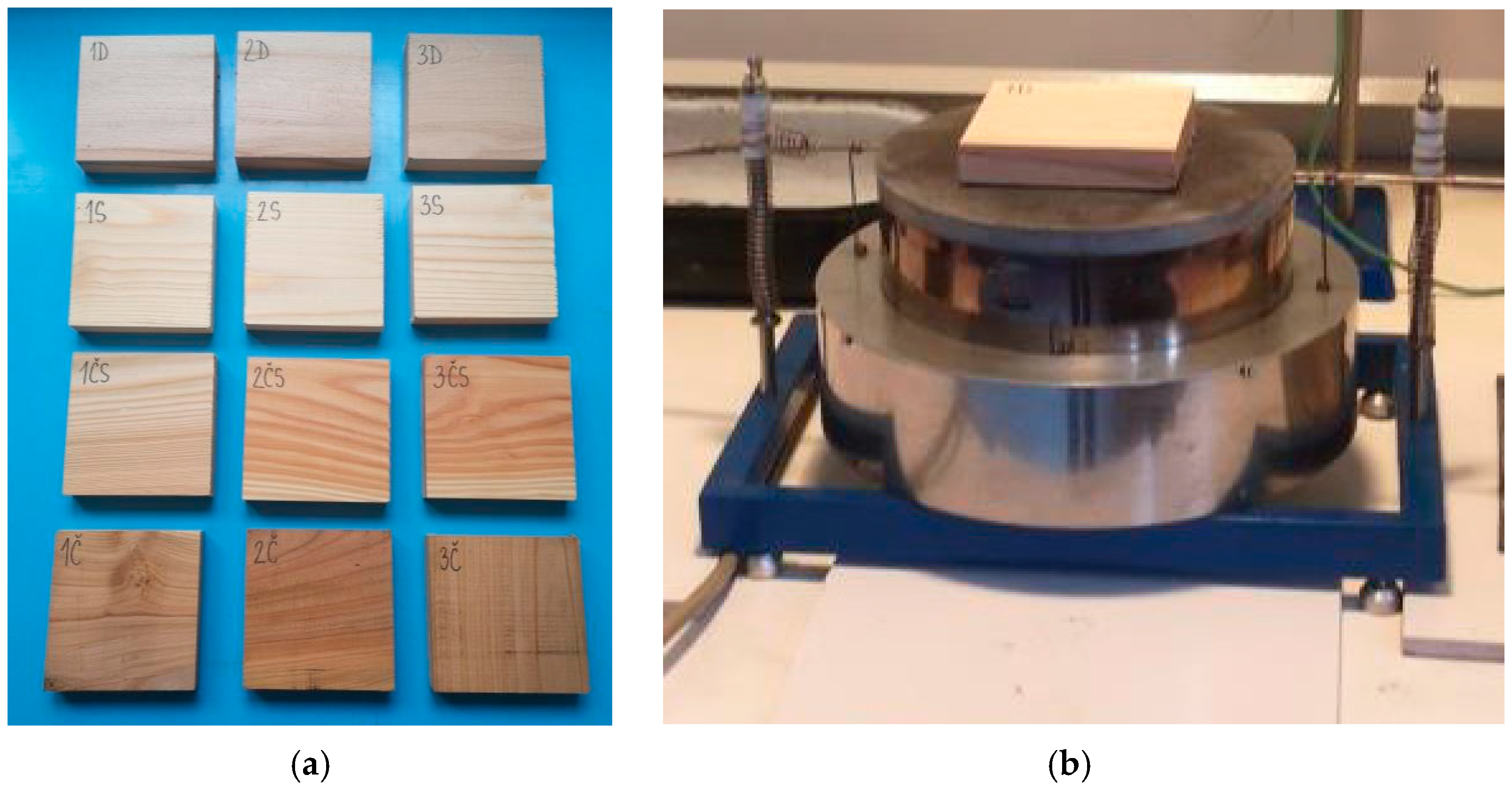
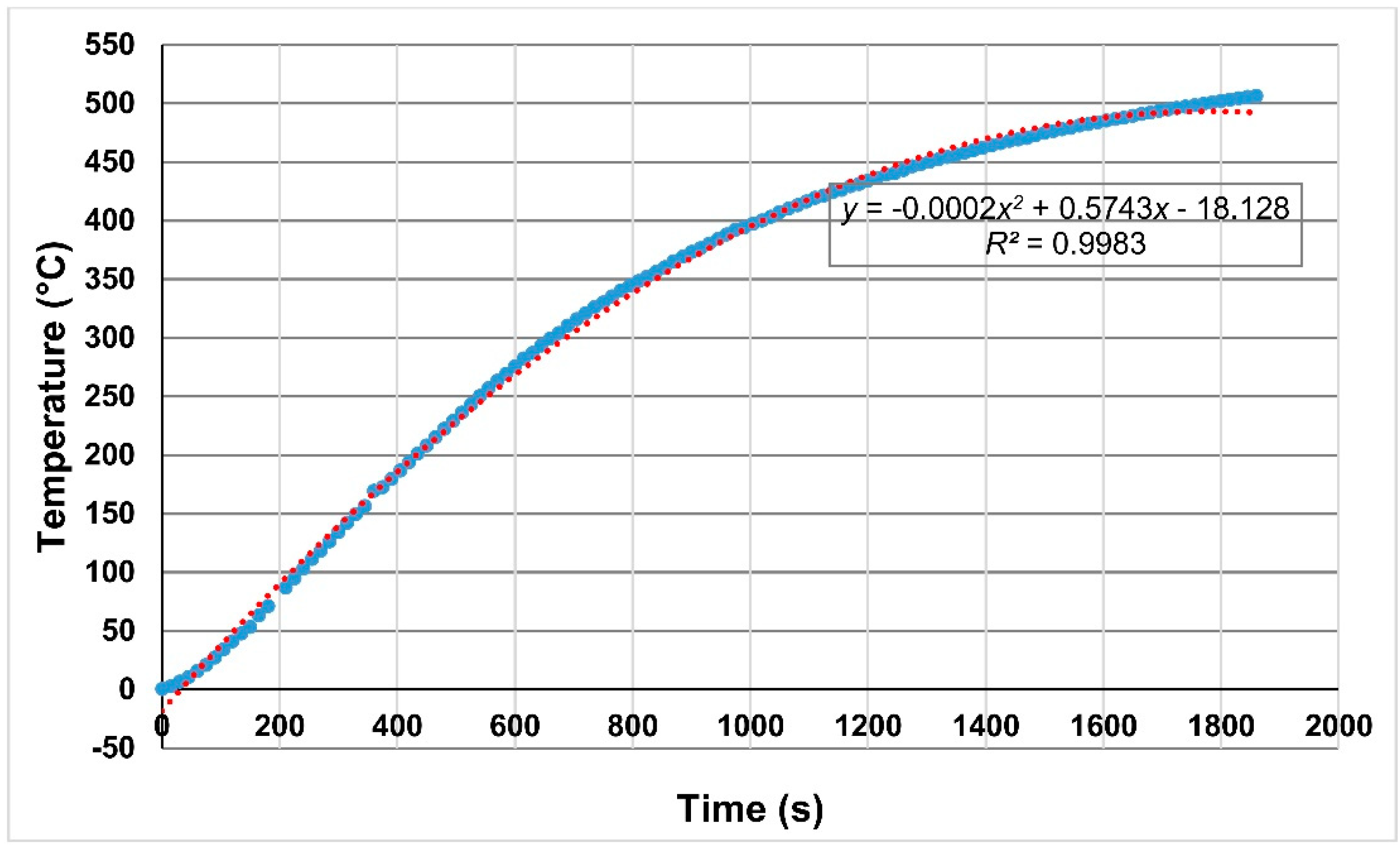
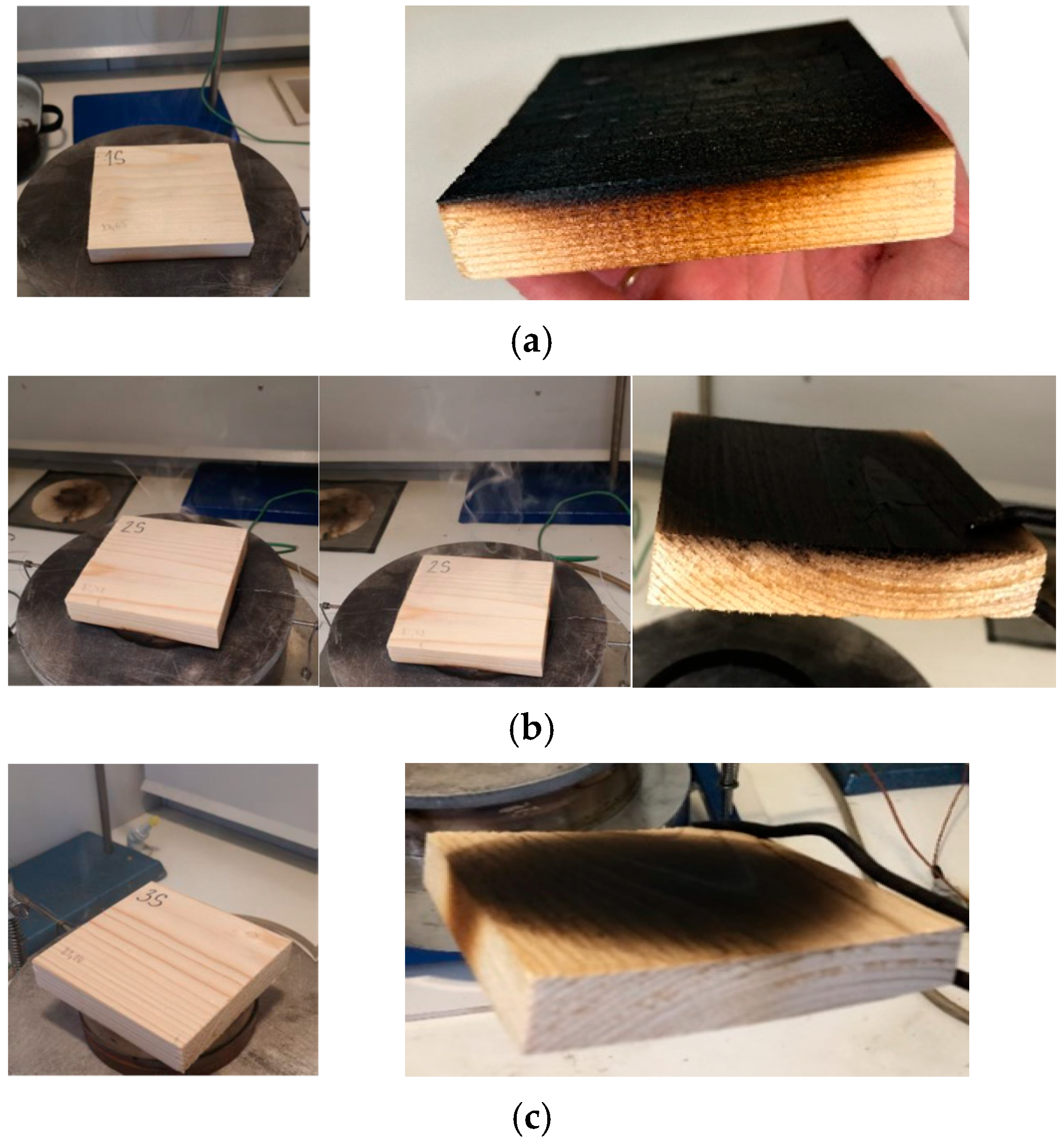
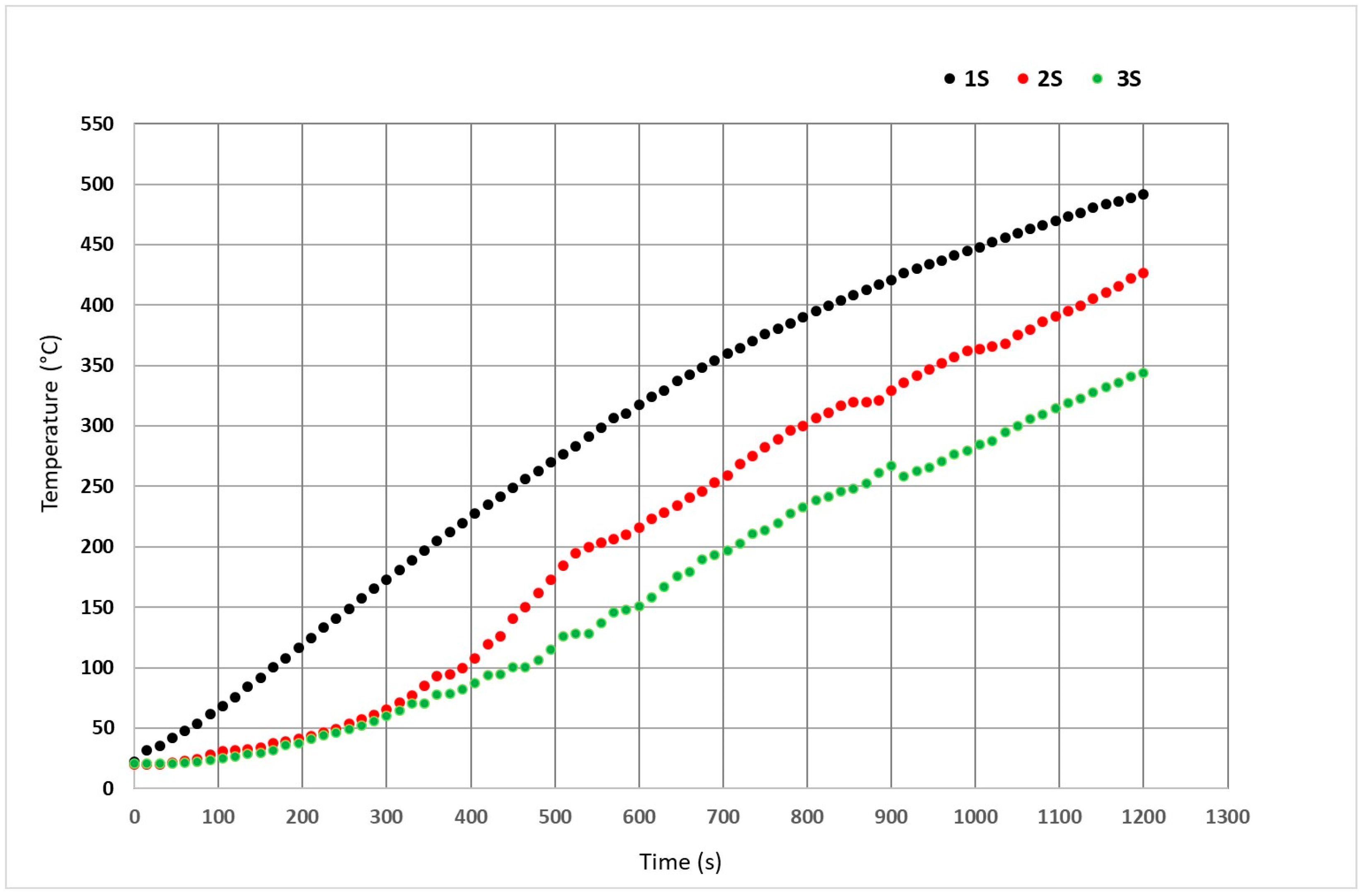
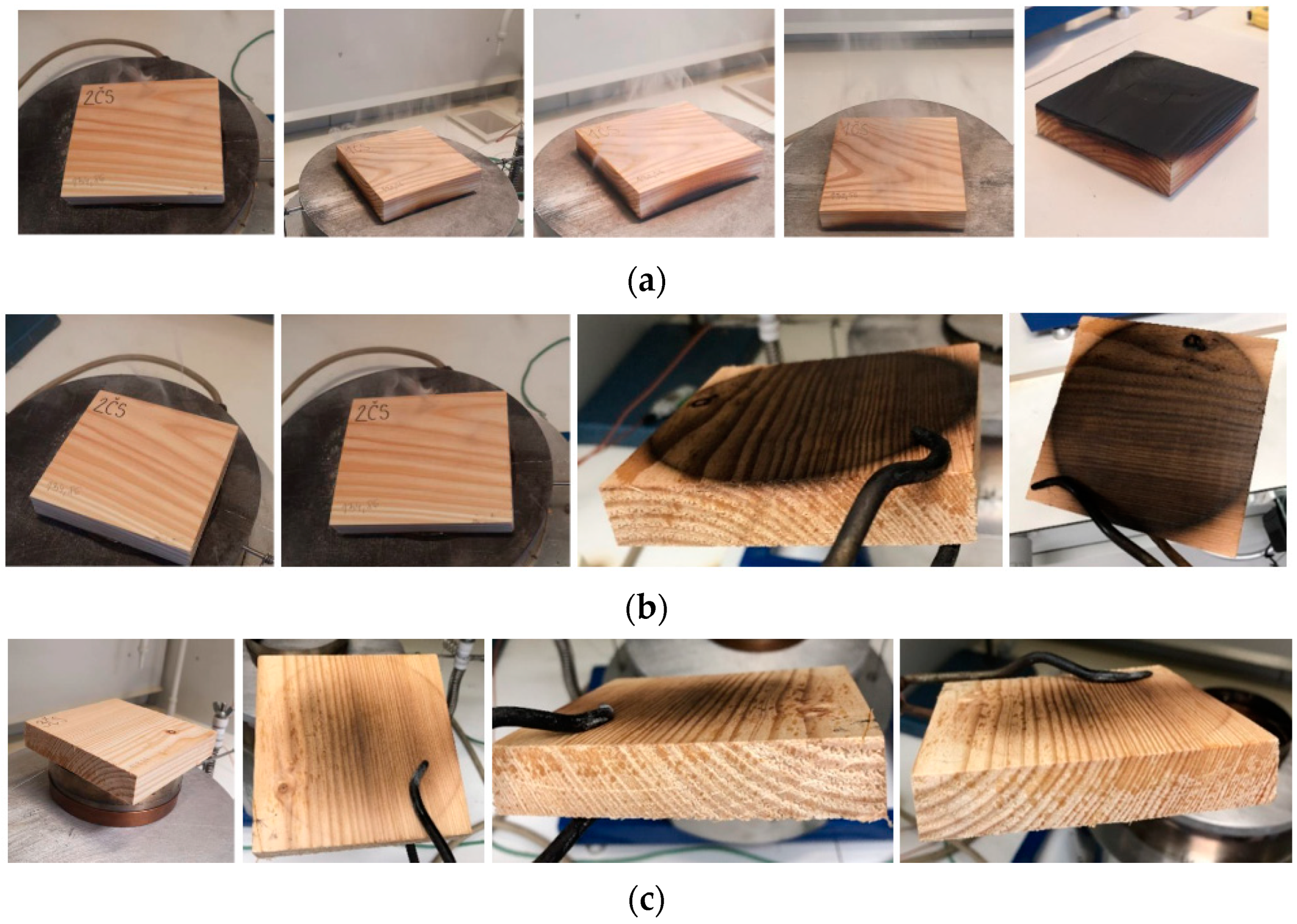
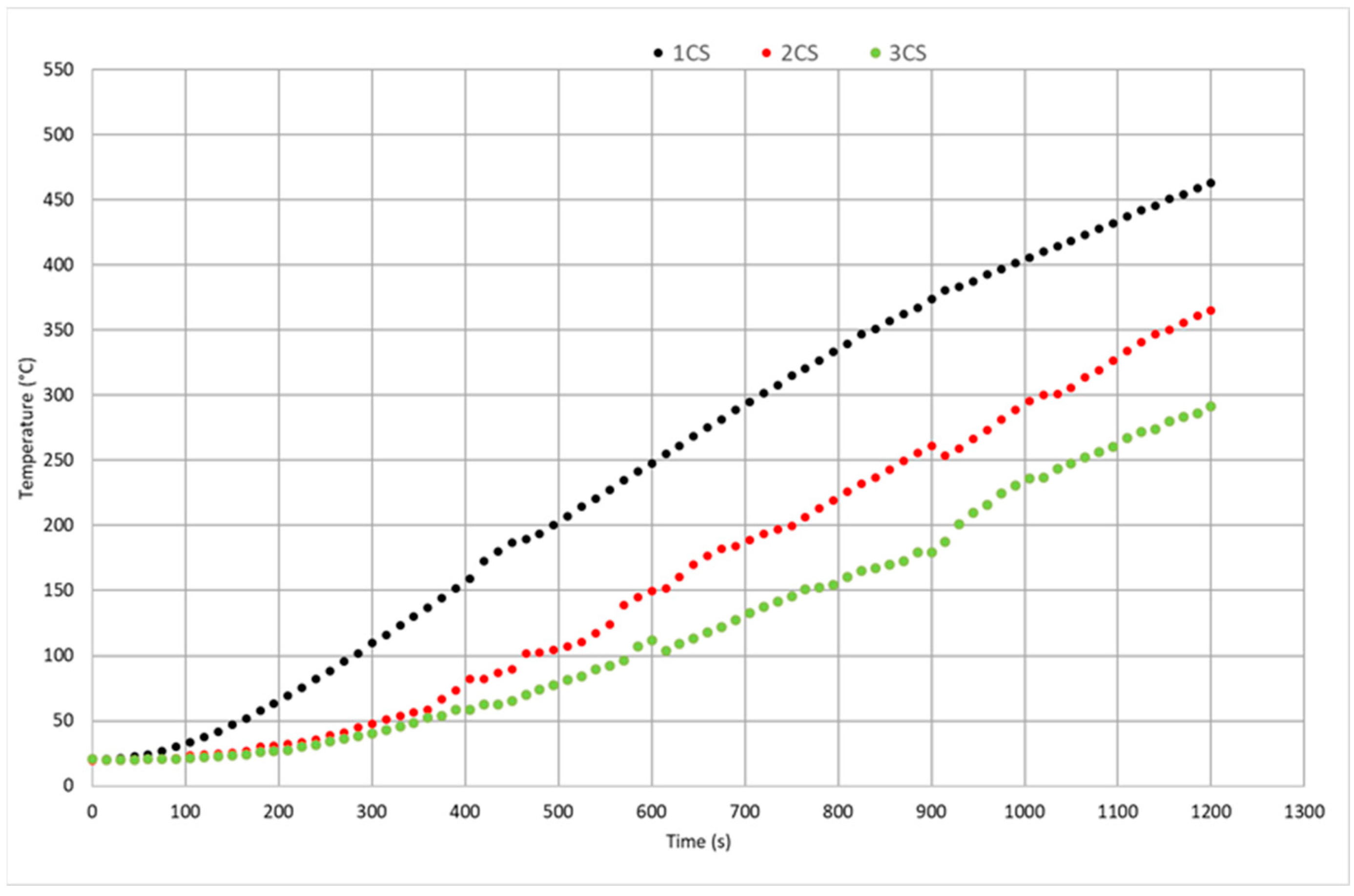
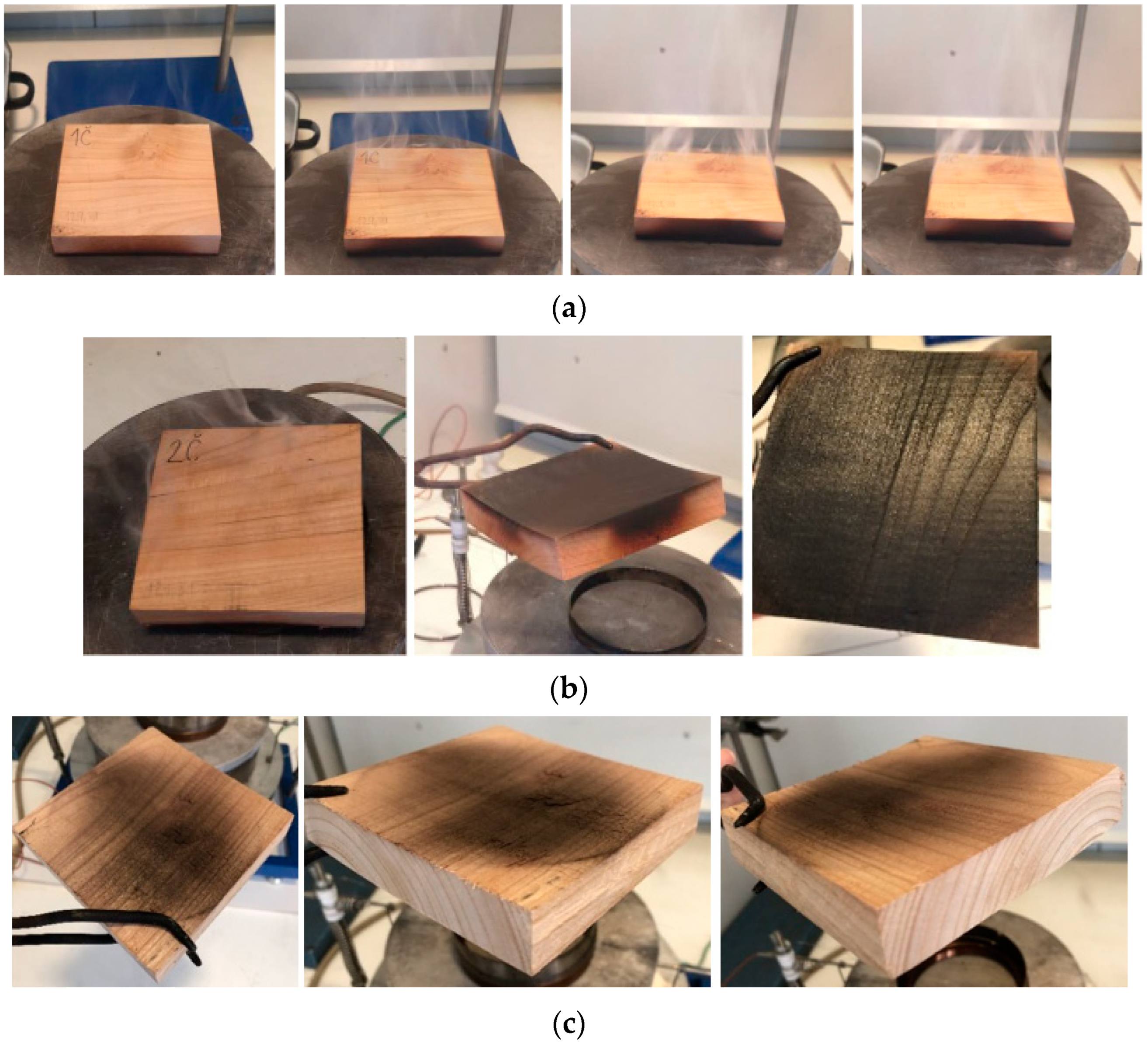
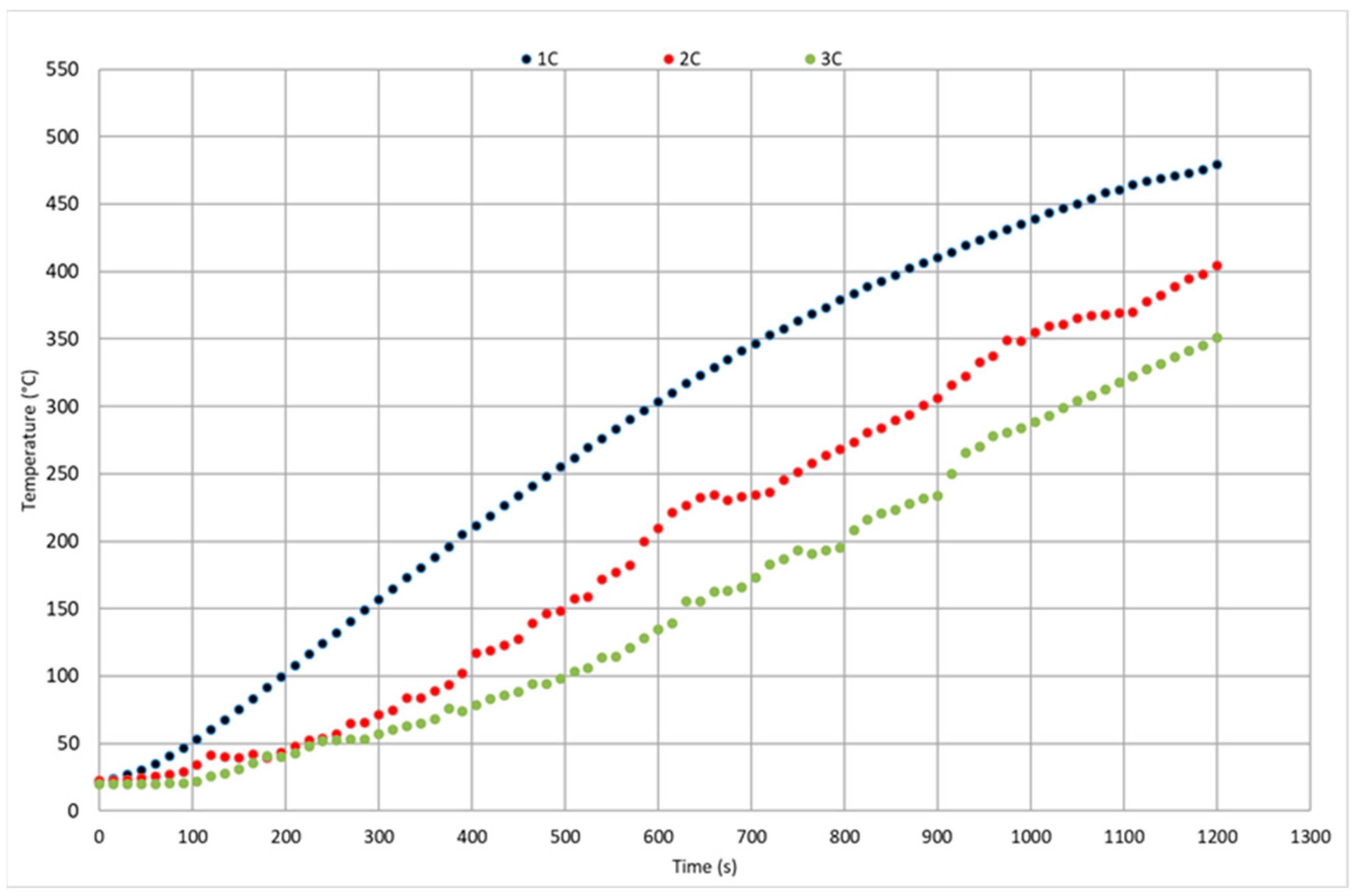
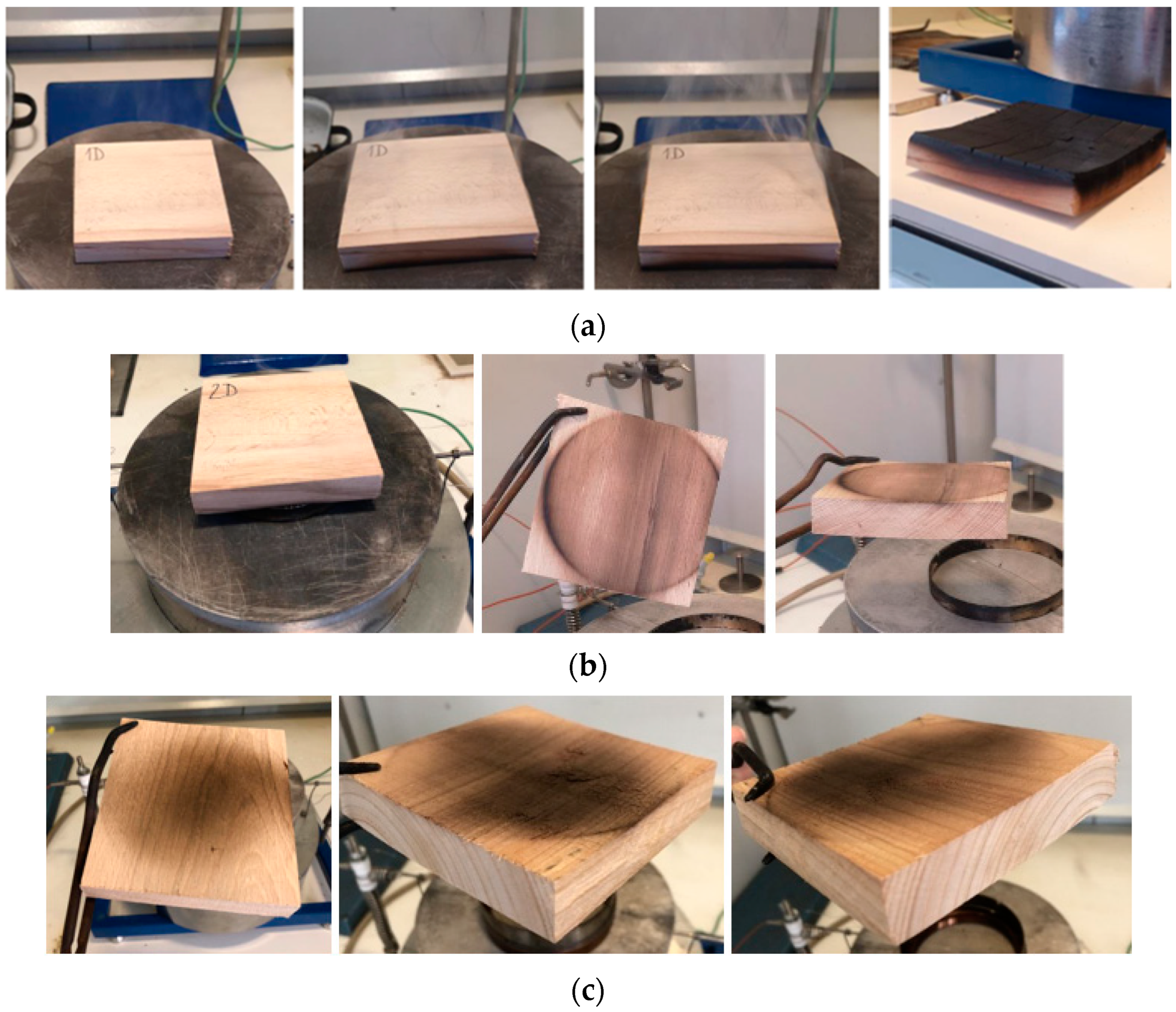
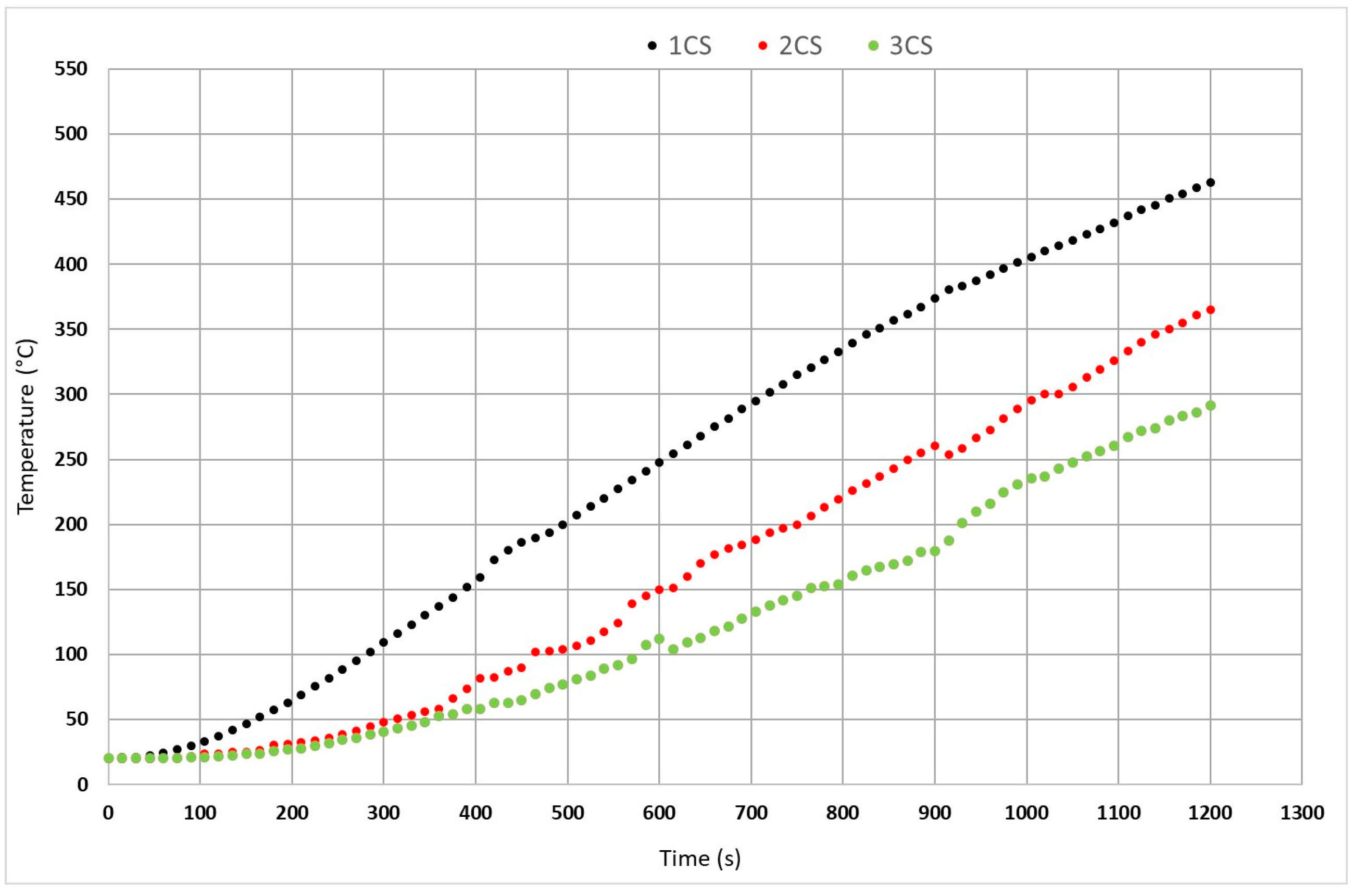


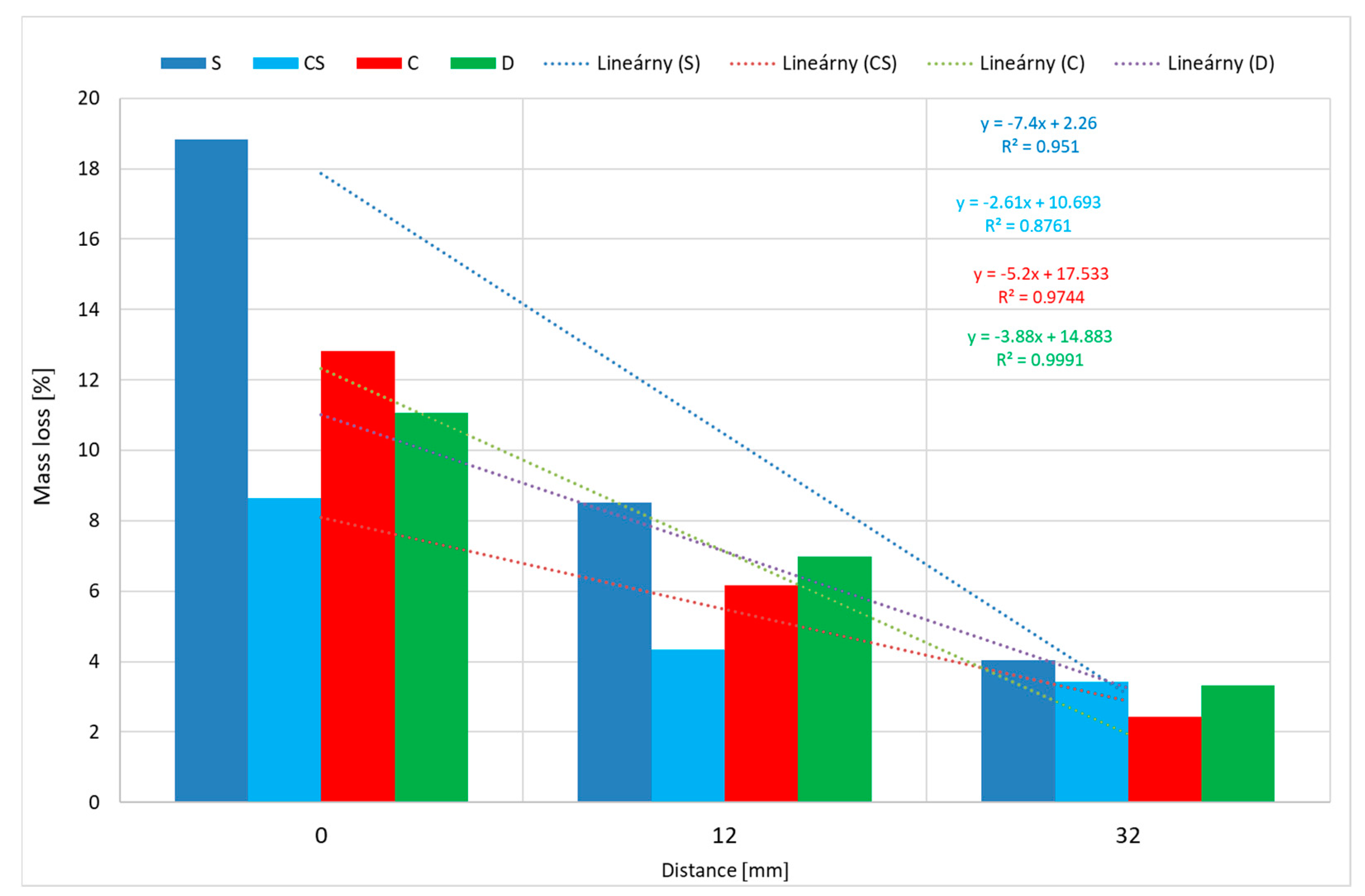
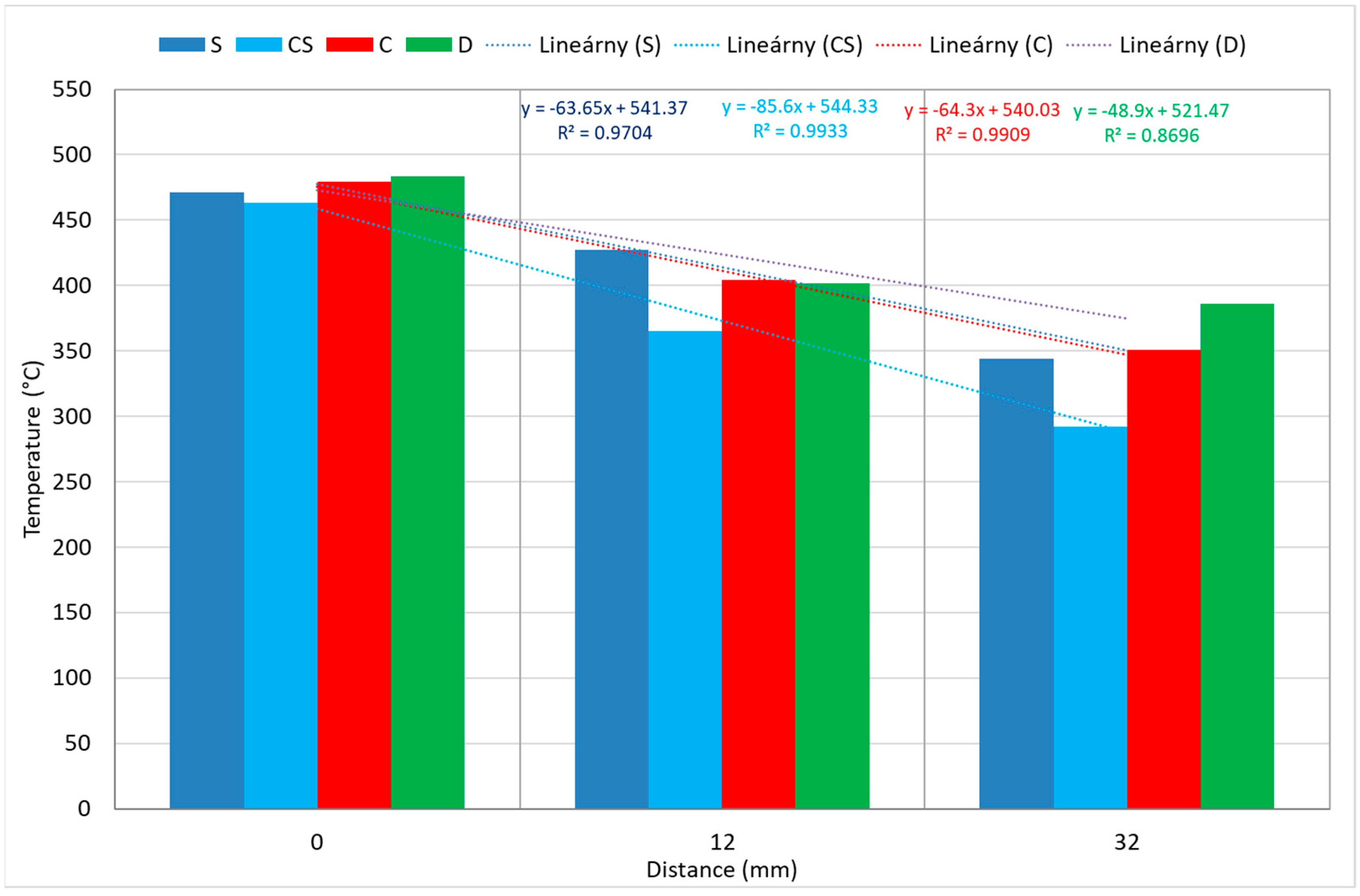

| Parameters | Soft Wood | Hard Wood | ||
|---|---|---|---|---|
| Spruce | Red Spruce | Cherry | Oak | |
| Mass (g) | 84.19 ± 3.22 | 130.05 ± 1.81 | 121.11 ± 7.24 | 131.37 ± 3.17 |
| Moisture (%) | 6.64 ± 0.78 | 7.24 ± 0.55 | 7.10 ± 2.17 | 7.51 ± 0.69 |
| Density (kg·m−3) | 421 ± 15.89 | 650 ± 8.64 | 605.67 ± 30.93 | 656.67 ± 15.32 |
| Distance Sample from Initiator | Spruce | Red Spruce | Cherry | Oak |
|---|---|---|---|---|
| 0 mm (contact with hot-plate surface) | 1S | 1CS | 1C | 1D |
| 12 mm | 2S | 2CS | 2C | 2D |
| 32 mm | 3S | 3CS | 3C | 3D |
| Distance from Initiator | Height of the Charred Layer (mm) | |||
|---|---|---|---|---|
| Spruce | Red Spruce | Cherry | Oak | |
| 0 mm | 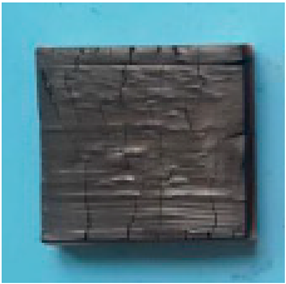 12 | 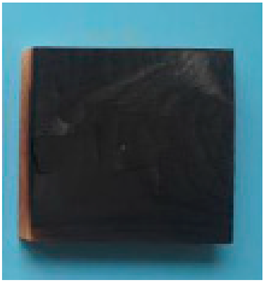 10 | 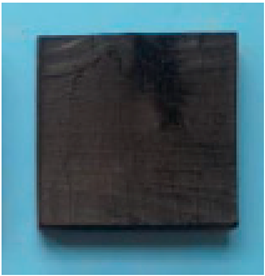 12 | 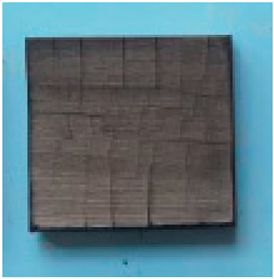 8 |
| 12 mm |  5 | 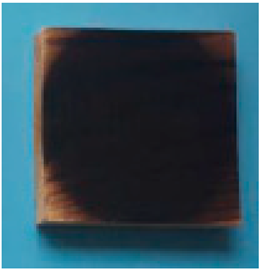 6 | 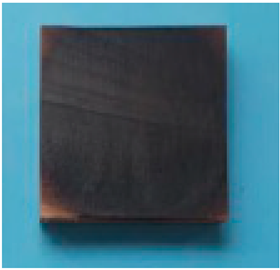 2 | 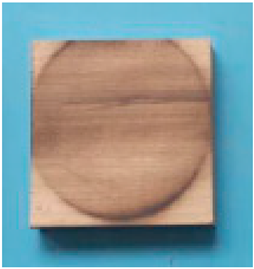 1 |
| 32 mm | 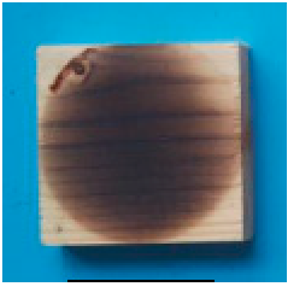 2 |  0 |  0 |  0 |
Disclaimer/Publisher’s Note: The statements, opinions and data contained in all publications are solely those of the individual author(s) and contributor(s) and not of MDPI and/or the editor(s). MDPI and/or the editor(s) disclaim responsibility for any injury to people or property resulting from any ideas, methods, instructions or products referred to in the content. |
© 2025 by the authors. Licensee MDPI, Basel, Switzerland. This article is an open access article distributed under the terms and conditions of the Creative Commons Attribution (CC BY) license (https://creativecommons.org/licenses/by/4.0/).
Share and Cite
Marková, I.; Jaďuďová, J.; Gašpercová, S.; Bóna, D. Monitoring the Thermal Degradation of Two Spruce Species, (Picea abies L., Picea rubens Sarg.), Cherry (Prunus avium), and Oak (Quercus spp.) Under the Influence of Radiant Heat. Appl. Sci. 2025, 15, 2065. https://doi.org/10.3390/app15042065
Marková I, Jaďuďová J, Gašpercová S, Bóna D. Monitoring the Thermal Degradation of Two Spruce Species, (Picea abies L., Picea rubens Sarg.), Cherry (Prunus avium), and Oak (Quercus spp.) Under the Influence of Radiant Heat. Applied Sciences. 2025; 15(4):2065. https://doi.org/10.3390/app15042065
Chicago/Turabian StyleMarková, Iveta, Jana Jaďuďová, Stanislava Gašpercová, and Dušan Bóna. 2025. "Monitoring the Thermal Degradation of Two Spruce Species, (Picea abies L., Picea rubens Sarg.), Cherry (Prunus avium), and Oak (Quercus spp.) Under the Influence of Radiant Heat" Applied Sciences 15, no. 4: 2065. https://doi.org/10.3390/app15042065
APA StyleMarková, I., Jaďuďová, J., Gašpercová, S., & Bóna, D. (2025). Monitoring the Thermal Degradation of Two Spruce Species, (Picea abies L., Picea rubens Sarg.), Cherry (Prunus avium), and Oak (Quercus spp.) Under the Influence of Radiant Heat. Applied Sciences, 15(4), 2065. https://doi.org/10.3390/app15042065








